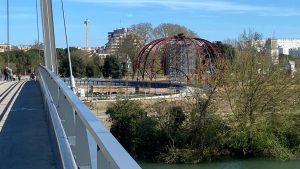Get stories like this delivered straight to your inbox. Sign up for The 74 Newsletter
The Los Angeles Unified School District is at a critical turning point, with fresh obstacles from both the recent wildfires and changes in federal aid and policies under the Trump administration, a new report argues.
The 26-page document, “Looking Ahead as LAUSD Confronts Fire Recovery and Federal Policy Uncertainty,” found those twin events will place new “operational and financial pressures” on the nation’s second-largest district in 2025 and beyond.
The report, published earlier this month by the L.A.-based nonprofit education advocacy group GPSN, points out that LAUSD was already strained, with cratering enrollment, intense budget pressure and mixed marks on recent state and federal exams, although it is making progress compared to the rest of the state by some metrics.
Other U.S. school districts are facing some similar post-pandemic headwinds and the second Trump administration, GPSN Executive Vice President Ana Teresa Dahan said in an interview, but the crisis at LA Unified is especially bad because of additional threats posed by the fires and years of plunging enrollment exacerbated by the pandemic.
“LAUSD was facing declining enrollment before these two crises occurred, and there’s a chance that this can make that worse,” said Dahan. “Between declining enrollment and delays in funding, LAUSD could find itself in a financial crisis.”
Morgan Polikoff, a professor of education at the University of Southern California, said the dangers to the district posed by the fires and the Trump administration are very serious.
“Those things are looming,” said Polikoff. “LAUSD would be a great target for the Trump administration if they want to put a trophy on the shelf.”
Drawing on academic research, news reporting and publicly available data, the GPSN report found the wildfires which ripped through Los Angeles in January affected more than 700,000 students and staff with school closures and displacements at the height of the disaster.
Even schools that were spared by flames suffered smoke damage, debris, and environmental hazards, according to the report.
Ongoing hardships caused by the fires, such as financial uncertainty caused by job losses — estimated at 25,000-45,000 in the report — and the displacement of families from lost homes and neighborhoods, also compound LAUSD’s fire woes, said Dahan.
Meanwhile, LA school officials are preparing for the Trump administration to change, cut, or significantly diminish federal funding for public schools, which typically accounts for about 10% of the district’s budget.
Trump on Thursday issued an executive order to shut down the U.S. Department of Education. He has also threatened to withhold funding for districts that use race-based programming.
LAUSD last year was forced to overhaul its signature program for Black students, the Black Student Achievement Plan, after a Virginia conservative group filed a civil rights complaint against the program.
LAUSD Superintendent Alberto Carvalho has said he would fight to impose any restrictions placed on the district.
Merely the fear of federal immigration enforcement at LAUSD schools, and uncertainty about the status of federal funding, could be enough to depress attendance and cause budgeting troubles for the district, Polikoff said.
In a written response to the GPSN report, a district spokesperson acknowledged the dangers faced by LA Unified.
“As this report correctly indicates, these are challenging times,” a district spokesperson said in a statement. “Not only is our community still recovering from the impact of the Palisades and Eaton fires, but we are now facing an increasingly volatile economic and political landscape.”
The GPSN report gave LA Unified high marks for quickly relocating two schools that were destroyed in the fires, and formarshaling resources to provide food for families at LAUSD campuses while schools were closed.
Dahan said she also found hope for LAUSD in the district’s state test scores, which show that it is closing the gap with the rest of California, in both reading and math.
To maximize its chances of mustering a strong recovery from the fires, and an effective response to the new federal landscape, Dahan said LA Unified needs to double down on social and academic services for students, and work with local community groups to bring those things directly to families.
“I think that they have demonstrated that they know how to respond to these crises,” Dahan said. “Now the real test will be, what does this mean for instruction and academics moving forward?”
Get stories like these delivered straight to your inbox. Sign up for The 74 Newsletter








